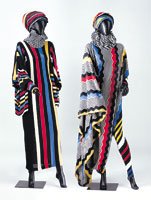'Theater In Fashion' Debuts at New Wallis Annenberg Center for the Performing Arts
When a legendary designer such as Gianni Versace creates the costumes for an operatic production, sometimes the designer receives more buzz than the opera itself.
The new Wallis Annenberg Center for the Performing Arts in Beverly Hills explores this fascination with couture designers and their impact on the operatic, theater and dance stage in the center’s first exhibit, “Teatro alla Moda—Theater in Fashion,” which opens Oct. 14.
The exhibition showcases more than 80 costumes, sketches and drawings from Armani, Fendi, Alberta Ferretti, Missoni, Emanuel Ungaro, Valentino and Versace, among others.
The designs were previously exhibited in Italy (in Rome, Brescia and Milan) and will head to Venice after a limited run in Los Angeles. While construction of the new Annenberg performing-arts venue is being completed, the exhibit is on display nearby at 253 N. Beverly Drive on the ground floor of the new MGM Place, which is being converted into a temporary gallery.
The exhibition was originally curated by Massimiliano Capella, director of Italy’s Musei Mazzucchelli, who said each designer’s distinctive look is apparent in the costumes.
“The relationship between theater and fashion has allowed the designers to leave their own unique mark on theatrical events,” Capella said. “These designers brought their signature styles and their love of the arts to the stage to capture the essence of the characters in the productions.”
Despite a long tradition of stage productions borrowing designers from the runway, designing costumes for the stage is a very different challenge than creating a clothing line, said Deborah Nadoolman Landis, costume designer and chair of the David C. Copley Center for Costume Design at the UCLA School of Theater, Film and Television.
“Fashion designers really don’t have to design thinking about the room you’re going to be sitting in, or the narrative context,” Landis said. “Costume designers serve the narratives and visual context of play.”
When fashion designers work for the stage, they must leave their role as a fashion designer at the door and focus more on the clothes as a tool to help the director tell the story, Landis explained.
The crossover from fashion designer to costume designer is not an easy one, as costumes are physically used differently than traditional clothing, said Jenny Green, costume director for the Los Angeles Opera, which enlisted Armani to help design the costumes for its production of “Rigoletto” in 2000.
“When designing for opera, the design choices have to incorporate the fact a singer must work in the clothes, sing, sit, sometimes run and jump, roll around on the floor, and any number of odd activities under hot lights,” Green said.
Despite these challenges, it’s a tradition that stretches back to the early 1900s and the days of Paul Poiret and Erteacute;, due to a fascination with the intersection of fashion, contemporary culture and costume design.
The “Theater in Fashion” exhibition features costumes from several productions, including “Lucia di Lammermoor” by Missoni; “The Clemency of Titus” by Ungaro; “The Dream of Valentino” by Valentino; “La Traviata” and “Carmen” by Fendi; and “Salome,” “Capriccio,” “Dionysos” and “Doktor Faustus” by Versace.
The exhibit runs until Nov. 13.
Hours for the exhibit are noon–7 p.m. (Wednesday to Friday) and 11 a.m.–6 p.m. (Saturday and Sunday). Tickets can be purchased at the door for $10 per person Thursdays through Sundays; children under 12 and students with valid ID have free admission. Admission on Wednesdays is free for everyone.
The Wallis Annenberg Center for the Performing Arts is scheduled to open in Fall 2013.—Deidre Crawford

























